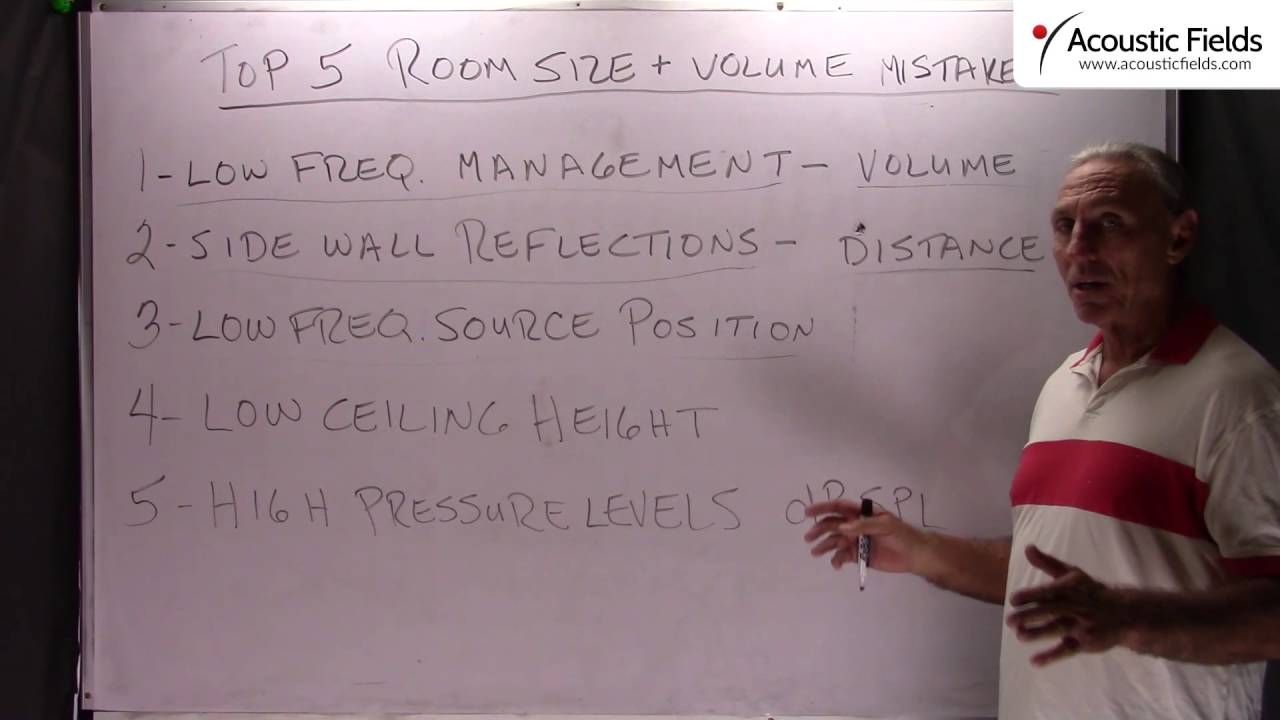Today we’re going to talk about the top 5 room size and volume mistakes. In audio rooms where you’re producing energy, that’s full frequency energy: low, middles and highs, you have to select the right size and volume for the usage.
I see too many times too small room, too much energy and treatment won’t even help at that point. So we have put together a couple of graphs and charts to help you with this and we’ll include those at the end of this video so you can kind of see the relationship between size and volume subwoofers, size and volume and room usage.
So obviously the first thing we have to consider in our smaller rooms today is just low frequency management. You know, subwoofer energy, low frequency generating devices, all need volume. They need volume so that they can release their energy and then you can manage it correctly. If the room is too small then you just add more room sound. So then you’re fighting room sound and high pressures from the low frequency.
So if you don’t have the right room volume to deal with the amount of energy that you have then you’re kind of beat before you start because treatment will not help in most cases. So volume is critical in low frequency management.
Side wall reflections, also very critical. We know in our monitoring, in our listening position it’s always a balance between direct and reflected energy. So if our side walls are really close then we have this primary, secondary, tertiary reflection points that are very close to each other and managing that so that it balances between the direct energy from the speakers is always critical.
So we need appropriate distances to work with. And I don’t see those a lot of times. In fact, a lot of times I see speakers right against the walls. I see speakers in the corners of rooms and that’s just wrong, completely wrong. So you don’t want to do anything resembling that. We’re trying to eliminate room sound, not increase it. Putting your speakers close to a boundary surface increases room sound by as much as 3, 4, 5, even 6 dB. So you have to be very, very careful.
Here’s another thing that we need to concentrate on low frequency source positions. If you have good volume and you have good room size, the next step is to position your low frequency producing devices in the right position in the room. There is this place in all rooms where the low frequency generating device can actually be positioned correctly to make sure that the room response is smoother. Maybe if you choose this position for our subwoofer we get this response. Maybe if we choose this position we get a smoother response. So we get less of an energy problem that we have to create and treat.
So there are different places in the room depending on size and volume where that low frequency energy device should be placed. Subwoofer is a good example that produces a smooth response curve. You’re having difficulty figuring that out, send me your room dimensions and I can help you. We have that information in our database.
Here’s another one that people constantly fight, especially here in North America: low ceiling height. Remember, you’re sitting on the floor. So the reflections from your speaker, from the ceiling to you and from the floor to you are the first ones that you receive. In North America we have that dreaded 8 foot ceiling height which is one of the worst dimensions in acoustics that you can have.
So always try to get a volume and a size that allows for an appropriate ceiling height. What’s ideal? 14 feet. I know, it’s high but that’s ideal acoustically because it’s a nice balance between treatment and function. So try to get as high a ceiling height as you can. Stay away from 8 foot.
High pressure levels. People are monitoring and listening at too high of pressure levels for their room size and volume. Your room has a certain break point, a certain Shroeder frequency if you will where the energy of the room and the energy of the system kind of balance each other out and you have to make sure that you’re not running a 100 dB SPL in a closet so to speak.
So you have to match the listening pressure levels that you’re using within the room size and volume. Low frequency management is a volume issue. Side wall reflections, always a distance issue. Low frequency source positions within the room to smooth out the frequency response and then add treatment. Low ceiling – height, stay away from 8 foot because the ceiling and the floor reflections are the first ones we have to manage correctly. And monitor and listen at proper levels that go with the room and keep everything in balance.








I have a question. I’m trying to determine if my room size is correct for live band jamming, not recording. My room is 16’x23’x10’. I will have drums piano electric guitars and vocalist. I do not need a control room, just a jamming room. i plan to soundproof so neighbors don’t complain. Also, my wife wants to use as a home theater room. Is this possible? Are my room dimensions acceptable for dual purpose?
B, Room dimensions are fine. However, you will need large amounts of broadband absorption inside the room
and walls that are 8″ – 12″ thick.
Theater and live rooms have different treatment requirements. It would be difficult to perform both of these functions in the same room.